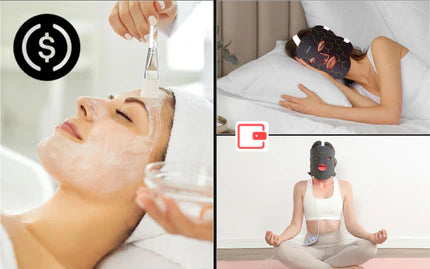If you’re looking for new ways to tackle health issues, red light therapy is becoming a popular option. It’s especially getting noticed for how it might help with thyroid problems—a big deal since so many people have these kinds of issues. Everyone’s on the lookout for treatments that don’t involve surgery or side effects, and that’s where red light therapy shines. In this guide, we’ll break down how it could be good for your thyroid, make sure it’s safe, and give you tips on how to use it.

What Is the Thyroid’s Vital Role in Your Body?
The thyroid is a gland located in the front part of your neck. It’s part of the endocrine system and is crucial for producing hormones, particularly thyroxine (T4) and triiodothyronine (T3), which regulate the body’s metabolism—the process by which the body converts what you eat and drink into energy. These hormones affect a wide range of bodily functions, including heart rate, body temperature, and how quickly you burn calories.
Thyroid disorders, such as hypothyroidism (underactive thyroid) and hyperthyroidism (overactive thyroid), can wreak havoc on overall health. Symptoms range from fatigue and weight fluctuations to mood disturbances and cardiovascular issues. The prevalence of these conditions has spurred interest in complementary therapies like red light therapy.
What Does Science Say About Red Light Therapy for Thyroids?
The scientific community has begun to shed light on the potential of red light therapy for thyroid health. Several studies have explored its effects on thyroid function and related disorders.
Researchers hypothesize that red light therapy benefits thyroid health through several mechanisms:
- Enhancing cellular energy production
- Reducing inflammation in thyroid tissue
- Improving local blood circulation
- Modulating the immune response in autoimmune thyroid conditions
While these findings are promising, it’s important to note that research is ongoing, and more extensive clinical trials are needed to fully elucidate the efficacy of red light therapy for thyroid issues.
What Are the Possible Benefits of Red Light Therapy for Your Thyroid?
Anecdotal evidence and preliminary studies suggest several potential red light therapy benefits for thyroid health:
- Reduced need for thyroid medication in some patients
- Improved thyroid function markers
- Enhanced overall well-being and energy levels
- Potential reduction in thyroid antibodies in autoimmune conditions
Some patients have reported significant improvements in their quality of life after incorporating red light therapy into their thyroid management regimen. However, it’s crucial to approach these testimonials with a balanced perspective, recognizing that individual responses can vary widely.

How to Use Red Light Therapy for Thyroid Health
For those considering how to use red light therapy for thyroid health, understanding the typical protocols is essential. Treatment sessions usually involve exposing the neck area to red and near-infrared light for a specified duration, often ranging from 10 to 20 minutes.
The frequency of treatments can vary, with some protocols recommending daily sessions, while others suggest 2-3 times per week. The intensity and specific wavelengths of light used may also differ depending on the device and individual needs.
Accessibility to red light therapy has expanded in recent years. While some may opt for treatments in clinical settings, the rise of red light therapy devices for home use has made this modality more convenient for many. Red light neck and chest straps have gained popularity as a targeted solution for thyroid-related applications.
What Are the Safety Considerations When Using Red Light Therapy?
A common question among those exploring this therapy is, “Is red light therapy safe for thyroid?” Generally, red light therapy is considered a low-risk treatment modality. However, as with any health intervention, it’s not without potential considerations.
Known side effects are typically mild and may include:
- Temporary redness or warmth in the treated area
- Slight eye strain if proper eye protection isn’t used
- Potential headaches in sensitive individuals
When focusing on the neck area for thyroid treatment, it’s crucial to follow guidelines meticulously to avoid overexposure. Always consult with a healthcare provider before beginning red light therapy, especially if you have pre-existing thyroid conditions or are taking thyroid medications.
What Are Some Practical Tips for Using Red Light Therapy for Thyroid Health?
When considering red light therapy for thyroid health, especially if you’re thinking about using neck and chest straps at home, it’s important to go about it thoughtfully. Let’s expand on those handy tips to ensure you get the most out of your experience.
1. Choose wisely: Take the time to research and pick out the best red light devices like neck and chest straps. Make sure they’re specifically designed for thyroid use. Check that they have the right wavelength range—typically between 600 to 850 nanometers is ideal. Also, look for FDA approval or other safety certifications to ensure the product’s reliability and safety standards.
2. Start slowly: Your body needs time to adjust to new treatments. Begin with sessions that last just a few minutes, and as you grow more comfortable and if you’re responding well, you can increase the duration up to the recommended time.
3. Keep it regular: Consistency is crucial with red light therapy. Set a schedule for your sessions, whether that’s every day or a few times a week, and stick to it. Regular exposure is key to allowing the light to potentially stimulate cellular activity and provide the benefits you’re looking for.
4. Watch your body’s cues: It’s very important to monitor how your body and symptoms respond to red light therapy. If you’re using it for thyroid health, keep an eye on energy levels, mood, and any physical thyroid symptoms. Also, regular thyroid function tests can help track any changes in your hormone levels objectively.
5. Fit it into your overall care: Red light therapy should complement your existing thyroid management plan, which includes medication, diet, and lifestyle modifications. It’s not a replacement for traditional medical treatments but rather an adjunctive option that may enhance your overall well-being.
6. Keep up-to-date: The field of red light therapy is always evolving with new research. Stay informed by reading the latest studies and guidelines or talking to professionals who specialize in this area.
Red light therapy, including using neck and chest straps, can be a great addition to your health toolkit, but it’s just one part of taking care of your thyroid health. Don’t forget to eat right, manage stress, and see your doctor regularly too.
Give Red Light Therapy a Try for Thyroid Health
Red light therapy is gaining attention, particularly among those with thyroid conditions. Recognized for its non-invasive approach, it may offer the additional support your thyroid requires. While further research is necessary to fully understand its optimal use, early results have been encouraging. If you’re intrigued, consider consulting with your healthcare provider to explore the most recent insights and determine if red light therapy could be beneficial for your thyroid health. Ultimately, it’s about promoting wellness and achieving a state of balance, whether red light therapy is a key component or a supplementary aspect of your health regimen.






